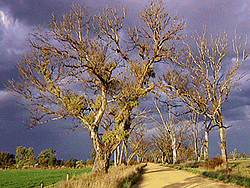Mundulla Yellows
In south-east South Australia a mysterious disease is posing a major threat to a wide range of native plants. The condition was discovered twenty years ago by beekeeper Geoff Cotton, who noticed conspicuous patches of yellow foliage in mature red gums (Eucalyptus camaldulensis) in the Mundulla area. Since then the problem has spread substantially, much to the concern of plant pathologist Dr. Frank Podger and ecologist Dr. David Paton. In the future, large areas of Australia will lose their Australian character:
“My personal forecast is that, should this process continue unabated, the south-east of South Australia will, in the not too distant future, lose the quintessential character of Australian landscapes evident in the works of Hans Heysen,” states Dr Frank Podger, CALM, WA.
Symptoms
The first symptoms to appear are patches of bright yellow leaves on one or more branches, gradually spreading through the crown of the tree or shrub. Large numbers of new shoots are usually produced, but these are often congested and deformed. Eventually classic dieback symptoms occur and within a few years the entire plant dies.
Which plants are affected?
Symptoms are occurring in a wide range of Australian native plants including acacia, allocasuarina, dianella, dampiera, kunzea, banksia, hakea, callistemon, melaleuca, eucalyptus, angophora, corymbia, bursaria and xanthorrhoea. The disease has been found across Tasmania, Western Australia and New South Wales as well as in South Australia.
What can be done about Mundulla Yellows?
Very little is known about Mundulla Yellows at present. Scientists think it may be caused by a phytoplasma (an organism that lives inside plant cells) or by a virus. In either case, the disease is possibly being transmitted by sap-sucking insects. There is no known cure.
What is certain is that this disease represents a serious threat to the biodiversity of Australia, and research is needed to identify the cause and prevent further spread.
Contact information
Dr. David Paton
Ecologist
University of Adelaide
Phone: (08) 8303 4742 Dr. Frank Podger
Plant Pathologist
CALM, WA
Phone: (08) 9343 3290



